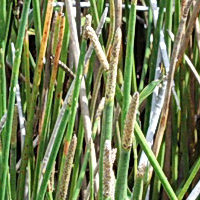Horsetail spike-rush
Scientific name: Eleocharis equisetoides


Cover photo credit: efoloras.org
Status
Endangered
“Endangered” means the species lives in the wild in Ontario but is facing imminent extinction or extirpation.
Date added to the Species at Risk in Ontario List
The Horsetail spike-rush was already assessed as endangered when the Endangered Species Act took effect in 2008.
What it looks like
Horsetail Spike-rush is an aquatic, perennial plant in the sedge family. It reaches about 50 to 100 centimetres in height and grows in water four to 35 centimetres deep.
Horsetail Spike-rush flowers in the late spring and produces fruit from July to October. The fruits are found at the tip of the stem and are covered in light brown scales. The plant has pale green, hollow, straw-like leaves that grow in tufts from a rhizome or tuber.
Where it lives
Throughout its range, the Horsetail Spike-rush grows in shallow water along the edges of ponds.
Where it’s been found in Ontario
View a Larger version of this map (PDF)
What threatens it
Potential threats to Horsetail Spike-rush at Long Point include: competition from Common Reed, an invasive plant species; changing water levels; and browsing by deer.
Small, isolated populations such as these are always prone to elimination by chance events such as a big storm.
Action we are taking
Endangered Species and their general habitat are automatically protected
Recovery strategy
A recovery strategy advises the ministry on ways to ensure healthy numbers of the species return to Ontario.
Read the executive summary (December 7, 2011)
Read the recovery strategy (December 7, 2011)
Government response statement
A government response statement outlines the actions the government intends to take or support to help recover the species.
Read the government response statement (September 7, 2012)
Five-year review of progress
A five-year review of progress made toward protecting and recovering a species is required no later than five years after the government response statement for that species is published.
Read the report on progress towards the protection and recovery of six species at risk, including Horse-tail Spike-rush (2017).
Habitat protection
General Habitat Protection - June 30, 2008
What you can do
Report a sighting
The Ministry of Natural Resources and Forestry tracks species at risk such as the Horsetail spike-rush. Report a sighting of an endangered animal or plant to the Natural Heritage Information Centre. Photographs with specific locations or mapping coordinates are always helpful.
Volunteer
Volunteer with your local nature club or provincial park to participate in surveys or stewardship work focused on species at risk.
Be a good steward
- Private land owners have a very important role to play in species recovery. If you find Horsetail-spike-rush on your land, you may be eligible for stewardship programs that support the protection and recovery of species at risk and their habitats.
- Invasive species seriously threaten many of Ontario’s species at risk. To learn what you can do to help reduce the threat of invasive species, visit:
www.ontario.ca/invasivespecies
www.invadingspecies.com
www.ontarioinvasiveplants.ca
www.invasivespecies.gc.ca.
Report illegal activity
Report any illegal activity related to plants and wildlife to
Quick facts
- Horsetail Spike-rush is pollinated by the wind. It may also be dispersed by waterbirds, as the seeds are known to remain viable after passing through the guts of waterbirds.
- Horsetail Spike-rush is at the northern extreme of its natural range in Ontario.
- Horsetail Spike-rush was used by the Seminole Indians to make beads for jewelry.
